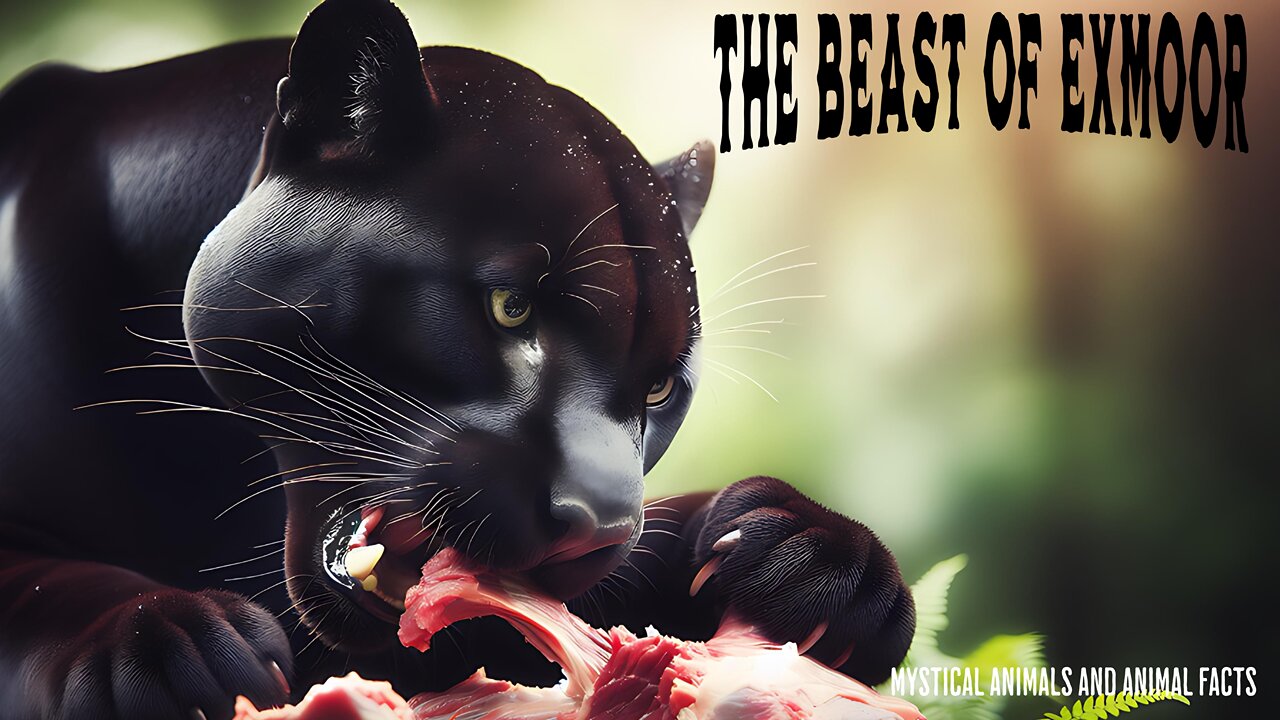Premium Only Content

The Beast of Exmoor Mystery on the Moor - mini documentary
Shirts and more
Designs Redbubble
https://www.redbubble.com/people/ReneMM/shop?asc=u
Spreadshirt.at
https://www.spreadshirt.at/shop/user/renemm/?srEdit=pa#?affiliateId=1257693
Spreadshirt.com
https://www.spreadshirt.com/shop/user/renemm/?srEdit=pa#?affiliateId=11625
Shirtee.at
https://www.shirtee.com/de/catalogsearch/result/index/designer_id/112048/all_stores/
1/
The Beast of Exmoor refers to a mysterious predator or group of animals that has been sighted in the Exmoor region of southwestern England since the early 1980s and is believed to be responsible for the deaths of numerous farm animals, particularly sheep. The first significant reports began to accumulate around 1983, when farmers in the counties of Devon and Somerset noticed unusually high losses in their sheep flocks. The nature of the kills caused a stir: the animals had often been killed with great precision and extraordinary force, and the bites did not always correspond to the known patterns of native predators such as foxes or feral dogs. Particularly in the area between South Molton and Porlock, a striking number of sheep were killed in often mysterious ways. Eyewitness descriptions of the unknown animal were often similar: it was described as large, black or dark gray in color, with a long tail and a cat-like shape, moving at great speed and with fluid, cat-like movements. The size estimates varied, but many witnesses reported seeing an animal significantly larger than a fox, some even larger than a sheepdog. The frequency of the incidents and the financial losses suffered by farmers led to considerable concern and public attention. In 1983, the Livestock Defense Committee was formed, a group of concerned farmers who took measures to protect their herds and searched for the animal themselves. The damage was considerable; this committee alone reported over 100 sheep that were said to have been killed within a few months. The situation escalated to such an extent that even the British military was called in: in 1983, at the request of the local member of parliament, the Ministry of Defense deployed a unit of the Royal Marine Commandos to comb the area, but without finding or killing the animal. This unsuccessful operation further contributed to the mystification of the beast. In later decades, sightings and reports of unexplained sheep killings continued unabated. In 2006, local MP Colin Breed again called for an official investigation into the incidents in the House of Commons after further unexplained attacks on livestock were reported. Although the loss of sheep to predators is not unusual in a rural region such as Exmoor, the specific nature of the killings, the immense number of victims at peak times, and the consistent descriptions of a large, cat-like predator distinguished these cases from ordinary incidents. The most plausible zoological explanation, put forward by experts such as naturalists at the Natural History Museum and experienced hunters, is that of an escaped or abandoned large predator, most likely a puma or black panther. Big cats have been kept as exotic pets in the UK in the past, and there are documented cases of escape or deliberate release after the Dangerous Wild Animals Act of 1976 came into force, which severely restricted the keeping of such animals. The hilly, hedge- and forest-strewn landscape of Exmoor potentially offers sufficient cover and prey for a single, reclusive predator to remain undetected for years. Skeptics attribute the sightings to misidentifications of native animals such as large dogs, foxes, or even deer under certain lighting conditions, and see the sheep kills as the work of dogs or foxes, the extent of which has been inflated by panic and exaggeration. Despite intensive searches, the use of night vision equipment, camera traps, and occasional shooting permits for hunters, the existence of a single, identifiable animal called the “Beast of Exmoor” has never been proven beyond doubt. No carcass has ever been found, no clear photo has been taken. Nevertheless, the legend of the Beast of Exmoor persists to this day. It is deeply rooted in local folklore and remains a fascinating, unsolved mystery of British cryptozoology. Occasional new sightings or unexplained livestock kills keep interest in the phenomenon alive and fuel the idea that a large, unknown predator could still be prowling the remote valleys and moorlands of Exmoor, a silent hunter that successfully eludes definitive proof. The Beast of Exmoor thus symbolizes the untamed wilderness within the seemingly well-mapped and controlled landscape of England. A truly interesting beast. I would be very happy to receive a like and a subscription.
-
 LIVE
LIVE
Red Pill News
2 hours agoBolton Grand Jury Reviewing Evidence NOW on Red Pill News Live
3,654 watching -
 LIVE
LIVE
Wayne Allyn Root | WAR Zone
6 hours agoWatch LIVE: The War Zone Podcast with Wayne Allyn Root
55 watching -
 1:23:55
1:23:55
Benny Johnson
2 hours ago🚨Trump LIVE Right Now at Emergency Press Conference with FBI Director Kash Patel in Oval Office
42.8K37 -
 3:22:05
3:22:05
Right Side Broadcasting Network
8 hours agoLIVE: President Trump Hosts a Press Conference with FBI Director Kash Patel - 10/15/25
119K16 -
 44:24
44:24
Clownfish TV
4 hours agoCNN is Angry 'The Male Gaze' Returned! TRADWIVES and SYDNEY SWEENEY are Blamed?! | Clownfish TV
17.7K14 -
 LIVE
LIVE
LFA TV
20 hours agoLIVE & BREAKING NEWS! | WEDNESDAY 10/15/25
1,137 watching -
 LIVE
LIVE
freecastle
6 hours agoTAKE UP YOUR CROSS- CONTEND earnestly for the FAITH once for all entrusted to the Saints!
129 watching -
 1:09:38
1:09:38
vivafrei
3 hours agoLiquid Death-Gate! Text Message-Gate! Ostrich-Gate! AN
73.1K28 -
 1:19:39
1:19:39
The HotSeat
2 hours agoAmericans Are Turning Back to God — While Terror Rises Again in Gaza
15.2K -
 LIVE
LIVE
Owen Shroyer
2 hours agoOwen Report - 10-15-2025 - Government Shutdown Political Slop Show Continues
1,307 watching